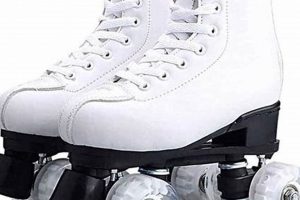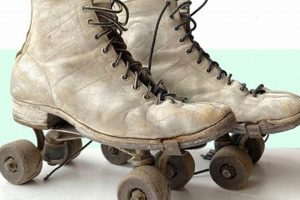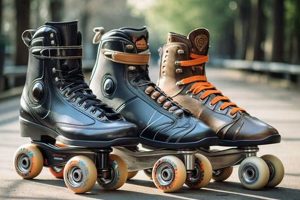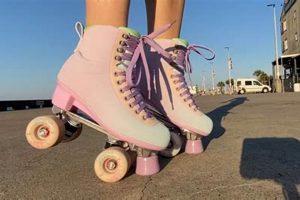Previously owned recreational footwear designed for gliding movement, typically featuring four wheels arranged in pairs on each boot, represents a cost-effective alternative to purchasing new equipment. These items, having been used by a prior owner, offer a means of engaging in a popular physical activity without incurring the full retail expense. An example would be a pair of quad skates, used by a teenager for a year and then sold online, allowing another individual to acquire them at a reduced price.
Acquiring pre-owned skating equipment presents several advantages. The reduced financial outlay makes the activity more accessible to a wider range of individuals, particularly those on a budget or new to the sport and unsure of their long-term commitment. Furthermore, reusing existing goods promotes environmental sustainability by extending the product lifecycle and reducing demand for new manufacturing. The practice of utilizing such equipment has a history as long as the sport itself, predating the mass production of affordable new models.
The following article will delve into considerations when selecting pre-owned skating equipment, outlining inspection points, safety precautions, and potential maintenance requirements to ensure a positive and safe experience. It will also address factors influencing pricing and the various marketplaces where such equipment can be found.
Tips for Purchasing Pre-Owned Roller Skates
Careful evaluation is paramount when considering the acquisition of previously owned skating equipment. Diligence in inspection and consideration of practical factors can mitigate potential risks and ensure user satisfaction.
Tip 1: Assess Structural Integrity: Thoroughly examine the boot for signs of wear and tear, including cracks, tears, or separation from the soleplate. Compromised boot integrity can negatively impact ankle support and overall control.
Tip 2: Inspect Wheel Condition: Evaluate wheel condition for excessive wear, flat spots, or cracking. Worn or damaged wheels can impede smooth rolling and compromise stability. Replacement may be required.
Tip 3: Evaluate Bearing Performance: Spin each wheel individually to assess bearing smoothness. Rough or noisy bearings may indicate dirt contamination or wear, potentially requiring cleaning or replacement.
Tip 4: Check Brake Functionality: Inspect the brake pad for wear and ensure its secure attachment to the frame. A worn or loose brake compromises stopping ability and safety.
Tip 5: Scrutinize Frame Alignment: Verify that the frame is straight and securely attached to the boot. Misalignment can affect balance and control, potentially leading to falls.
Tip 6: Size Appropriateness: Ensure the size matches the intended user. Improperly sized equipment can cause discomfort, blisters, and hinder proper skating technique. Trial fitting is recommended where possible.
Tip 7: Consider Intended Use: Match the equipment’s suitability to the intended skating style. Aggressive skating requires more durable equipment than recreational skating.
Adhering to these guidelines will contribute to a more informed purchasing decision, minimizing the risk of acquiring unsafe or unsuitable equipment. Emphasis on pre-purchase assessment is crucial for a positive experience.
The subsequent sections of this article will discuss appropriate safety gear and maintenance procedures to further enhance the user’s experience with used roller skates.
1. Affordability
The financial accessibility provided by pre-owned skating equipment constitutes a primary driver of its appeal. Brand-new equipment can represent a significant investment, potentially prohibitive for individuals on limited budgets or those uncertain about long-term participation in the activity. The pre-owned market offers an opportunity to acquire functional equipment at a substantially reduced cost. This price difference allows for the entry of new participants into the sport or enables experienced skaters to acquire additional equipment without incurring substantial financial strain. For example, families seeking recreational activities may find pre-owned options allow multiple members to participate where the cost of new equipment would restrict access.
The availability of lower-cost alternatives also influences purchasing decisions for growing children. As foot size changes rapidly, replacing skating equipment regularly can become expensive. The reduced cost of previously owned items mitigates this financial burden, allowing parents to prioritize proper fit and safety without undue concern for the investment lost due to growth. Similarly, individuals experimenting with different skating styles or disciplines, such as roller derby or artistic skating, may opt for pre-owned equipment to explore these areas without the commitment of a significant initial investment. This fosters broader participation and exploration within the skating community.
In summary, affordability represents a cornerstone of the pre-owned skating equipment market. By lowering the barrier to entry, it promotes wider participation, facilitates experimentation, and eases the financial burden of growing children’s equipment needs. Understanding this connection highlights the practical significance of the pre-owned market in expanding access to skating activities. While condition assessment remains crucial, affordability provides the essential foundation for many individuals to engage in this recreational pursuit.
2. Sustainability
The acquisition and utilization of pre-owned skating equipment directly relates to principles of environmental sustainability by promoting resource conservation and reducing waste. This practice lessens the demand for new manufacturing, mitigating the environmental impact associated with raw material extraction, processing, and transportation.
- Reduced Manufacturing Demand
Each new item of sporting equipment necessitates the consumption of resources and energy during its production. By extending the lifespan of existing items through resale and reuse, the demand for newly manufactured equipment is lessened, conserving resources and minimizing the environmental footprint associated with manufacturing processes. For example, fewer skates produced means lower energy consumption in factories and less waste generated in the production process.
- Waste Reduction
Discarding usable equipment contributes to landfill waste, posing environmental challenges related to space and potential contamination. Reusing equipment diverts it from the waste stream, reducing the volume of discarded materials and lessening the environmental burden associated with waste disposal. An example is the prevention of skates, still in usable condition, from ending up in landfills where their components might slowly degrade and release harmful substances.
- Conservation of Raw Materials
The production of new skates requires a variety of raw materials, including metals, plastics, and textiles. By utilizing pre-owned items, the demand for these raw materials is decreased, conserving natural resources and reducing the environmental impact associated with their extraction and processing. A real-world example is the reduced need for aluminum mining when skate frames are reused instead of being newly manufactured.
- Reduced Carbon Footprint
Manufacturing and transporting new goods contributes to greenhouse gas emissions, exacerbating climate change. By choosing pre-owned items, consumers can reduce their carbon footprint by minimizing the emissions associated with the production and transportation of new goods. A comparative analysis would reveal that the carbon footprint of purchasing a used pair of skates is considerably lower than that of purchasing a brand-new pair.
The practice of purchasing and using pre-owned skating equipment provides a tangible avenue for consumers to contribute to environmental sustainability. This approach fosters responsible consumption habits and reduces the environmental impact associated with the production, consumption, and disposal of sporting goods. Further, promotion of this practice can reinforce the environmental benefits associated with extending product lifecycles and reducing reliance on new manufacturing processes.
3. Condition Assessment
Condition assessment forms a cornerstone of responsible acquisition within the pre-owned skating equipment market. The viability of previously owned skates hinges directly on their structural integrity and functional capability. A failure to adequately evaluate the condition can lead to compromised safety, diminished performance, and ultimately, financial loss. The process involves a thorough examination of all components, from the boot and frame to the wheels and bearings, to identify any signs of wear, damage, or potential failure points. For instance, a seemingly minor crack in the boot’s shell can propagate under stress, leading to complete failure and potential injury. Similarly, corroded or damaged bearings can significantly impede the skates’ rolling efficiency, impacting the user’s ability to maneuver and control their movement.
The importance of condition assessment extends beyond immediate safety concerns. A comprehensive evaluation enables a potential buyer to accurately gauge the remaining lifespan of the skates and anticipate any necessary repairs or replacements. This information is crucial for determining a fair price and avoiding the purchase of equipment that will require significant investment shortly after acquisition. Consider the example of wheels with uneven wear patterns; this may indicate improper alignment or bearing issues, suggesting the need for immediate replacement. Furthermore, the condition of the brake pad directly impacts stopping ability and, consequently, user safety. A worn-out brake pad necessitates replacement, adding to the overall cost and potentially impacting the initial value proposition of purchasing pre-owned skates.
In summary, condition assessment represents an indispensable aspect of acquiring pre-owned skating equipment. It serves not only to mitigate safety risks but also to ensure a sound financial decision. Diligence in evaluating the structural integrity, functionality, and wear patterns of each component is paramount. Challenges in condition assessment often arise from a lack of expertise or inadequate inspection tools. However, a commitment to thorough evaluation, potentially supplemented by expert consultation, is essential for navigating the pre-owned market effectively and securing a safe, functional, and valuable product.
4. Size Appropriateness
The suitability of size in pre-owned skating equipment constitutes a critical determinant of user safety, comfort, and performance. Unlike purchasing new skates, where professional fitting services are often available, acquiring previously owned equipment necessitates careful consideration of size to mitigate potential risks and ensure optimal usability.
- Injury Prevention
Improperly sized skates can lead to a range of injuries, from blisters and abrasions to more severe ankle and foot problems. Skates that are too large provide insufficient support, increasing the risk of ankle sprains and instability. Conversely, skates that are too small can constrict circulation, causing discomfort and potentially leading to foot deformities over time. For example, using skates that are a size too small can compress the toes, leading to blisters and potentially contributing to the development of bunions or hammertoe. Proper sizing ensures adequate support and prevents unnecessary stress on the feet and ankles.
- Performance Optimization
Appropriate sizing directly impacts skating performance. Skates that fit well allow for better control and responsiveness, enabling the skater to execute maneuvers with greater precision and efficiency. Ill-fitting skates, on the other hand, can hinder technique and make it difficult to maintain balance. As an example, if skates are too large, the foot may slide around inside the boot, reducing the skater’s ability to control their movements and making it harder to perform turns or stops effectively. Correct sizing provides a stable and secure platform, facilitating optimal power transfer and control.
- Comfort and Enjoyment
Comfort is a key factor in determining the overall skating experience. Ill-fitting skates can cause discomfort and pain, detracting from the enjoyment of the activity. Skates that are too tight can cause blisters and chafing, while skates that are too loose can lead to foot fatigue and instability. For instance, skates that pinch the toes or rub against the heel can quickly become unbearable, making it difficult to skate for extended periods. Proper sizing ensures a comfortable and enjoyable skating experience, encouraging continued participation in the activity.
- Variations in Sizing Standards
Sizing standards can vary significantly between manufacturers and even between different models from the same manufacturer. What constitutes a “size 8” in one brand may not be the same as a “size 8” in another. This variability necessitates careful measurement and, ideally, a trial fitting before purchasing previously owned skates. Reliance solely on a numerical size without considering the specific manufacturer and model can lead to purchasing skates that do not fit properly. For example, an individual who typically wears a size 9 in one brand might find that they need a size 9.5 or even a size 10 in another brand to achieve a comfortable and secure fit. Always try to measure foot length and width and compare those measurements to a sizing chart provided by the manufacturer.
Therefore, ensuring size appropriateness when acquiring pre-owned skating equipment is not merely a matter of convenience but a fundamental requirement for safety, performance, and sustained enjoyment of the activity. The considerations detailed above highlight the potential pitfalls of neglecting this crucial aspect of the purchasing process and emphasize the need for diligence and informed decision-making.
5. Maintenance Needs
The necessity for diligent maintenance is amplified when dealing with previously owned skating equipment. Unlike new skates, where components are in pristine condition, used skates may exhibit wear and tear accumulated over time. Addressing these maintenance needs is crucial for ensuring safety, prolonging the equipment’s lifespan, and optimizing performance.
- Bearing Lubrication and Cleaning
Bearings, critical for smooth wheel rotation, are susceptible to dirt and debris accumulation, diminishing their efficiency. Regular lubrication with appropriate bearing oil and periodic cleaning with solvents are essential to maintain optimal rolling performance. Failure to address bearing maintenance can result in reduced speed, increased effort, and premature bearing failure. For instance, neglecting bearing maintenance can cause bearings to seize, potentially leading to falls and injuries. Consistent cleaning and lubrication prevent corrosion and friction, contributing to smoother rides and extended bearing life.
- Wheel Rotation and Replacement
Wheels, subject to uneven wear patterns based on skating style and terrain, require periodic rotation to ensure even wear and extend their lifespan. Regular rotation distributes wear across all wheels, preventing premature replacement of individual wheels. Additionally, wheels exhibiting significant wear or damage should be replaced promptly to maintain optimal grip and stability. An example includes swapping the front and rear wheels on skates, as the front wheels often endure more wear due to turning and stopping. Timely rotation and replacement guarantee a consistent and safe skating experience.
- Brake Pad Inspection and Replacement
Brake pads, responsible for stopping ability, gradually wear down with use. Frequent inspection of the brake pad is necessary to assess its thickness and effectiveness. A worn brake pad compromises stopping power, increasing the risk of collisions and injuries. Replacing the brake pad when it reaches a minimum thickness threshold is paramount for maintaining safe stopping capabilities. As an illustration, failing to replace a worn brake pad could significantly increase the stopping distance, potentially leading to accidents in urban environments. Regular inspection and timely replacement are essential for ensuring reliable braking performance.
- Boot and Frame Integrity Checks
The structural integrity of the boot and frame is vital for providing support and stability. Regular inspection for cracks, loose screws, and other signs of damage is necessary. Addressing these issues promptly prevents further deterioration and maintains the structural integrity of the skates. Neglecting boot and frame maintenance can lead to instability and potential equipment failure, increasing the risk of injuries. For instance, loose screws can cause the frame to detach from the boot, leading to a sudden loss of control. Consistent inspections and timely repairs ensure the skates remain structurally sound and provide adequate support.
In summary, diligent maintenance is paramount for pre-owned skating equipment. Consistent attention to bearing lubrication, wheel rotation and replacement, brake pad inspection, and boot/frame integrity checks extends the equipment’s lifespan, ensures safe operation, and optimizes performance. Adhering to a regular maintenance schedule mitigates potential risks associated with wear and tear, ultimately enhancing the user’s skating experience.
6. Safety Equipment
The utilization of appropriate protective gear is non-negotiable when engaging with skating activities, and this principle holds particular significance when using previously owned skating equipment. The condition of such equipment may be less certain compared to new items, making the implementation of additional safety measures paramount.
- Helmets
The primary function of a helmet is to protect the head from impact in the event of a fall. Head injuries represent a significant risk in skating, and a properly fitted helmet can substantially reduce the severity of such injuries. When purchasing pre-owned skating equipment, ensuring the helmet is in good condition, free from cracks or damage, is crucial. A damaged helmet may not provide adequate protection. Examples include concussions and skull fractures, which can be mitigated or prevented by wearing a helmet. The Consumer Product Safety Commission (CPSC) standards should be met by any helmet used for skating.
- Wrist Guards
Wrist injuries, such as fractures and sprains, are common in skating due to the tendency to brace oneself during a fall. Wrist guards provide support and protection to the wrists, reducing the likelihood and severity of these injuries. These are especially helpful for novice skaters. A real-world instance involves preventing a wrist fracture when falling forward. The protective gear absorbs some the force. These are essential for beginners learning to balance and control their movements.
- Knee Pads and Elbow Pads
Knee and elbow injuries, ranging from scrapes and bruises to more severe fractures, can occur during falls. Knee and elbow pads provide a protective barrier, cushioning the joints and reducing the risk of injury. For example, consider protecting against painful scrapes and abrasions on asphalt. This protective gear is crucial for skaters of all skill levels, particularly those attempting more challenging maneuvers.
- Mouthguards
Although less commonly used in recreational skating, mouthguards offer protection against dental injuries and concussions resulting from impacts to the face. In more aggressive skating styles or environments where collisions are more likely, mouthguards can provide an added layer of safety. Protecting the teeth and jaw from impact during a fall or collision is the function. A mouthguard can also help absorb and distribute force, potentially reducing the risk of concussion.
The integration of safety equipment represents a fundamental aspect of responsible skating, regardless of whether the equipment is new or pre-owned. Given the potential uncertainties associated with previously owned equipment, prioritizing the use of appropriate protective gear is crucial for mitigating risks and promoting a safe and enjoyable skating experience.
Frequently Asked Questions
This section addresses common inquiries regarding the acquisition and use of previously owned skating equipment. It is intended to provide clarification and guidance for potential buyers.
Question 1: What are the primary risks associated with purchasing pre-owned skating equipment?
Potential risks include compromised structural integrity, reduced functionality due to wear and tear, and the presence of hidden damage that may not be immediately apparent. Thorough inspection and assessment are crucial to mitigate these risks.
Question 2: How can the condition of used skates be reliably assessed before purchase?
A meticulous inspection of the boot, frame, wheels, and bearings is essential. Examine the boot for cracks, tears, or separation. Assess wheel wear and bearing smoothness. Verify brake functionality. Trial fitting is recommended whenever possible.
Question 3: Is there a specific lifespan to expect from pre-owned roller skates?
The lifespan of pre-owned skating equipment varies significantly based on the quality of the original construction, the intensity and frequency of previous use, and the level of subsequent maintenance. No specific lifespan can be guaranteed.
Question 4: What safety equipment is considered essential when using pre-owned skating equipment?
A properly fitted helmet that meets current safety standards is paramount. Wrist guards, knee pads, and elbow pads are also highly recommended to protect against common skating injuries.
Question 5: Are there specific maintenance procedures that are more important for pre-owned skates than for new skates?
While all skating equipment requires maintenance, pre-owned equipment necessitates more frequent and thorough inspection and maintenance due to potential pre-existing wear. Particular attention should be paid to bearing lubrication, wheel rotation, and brake pad condition.
Question 6: Where are reputable sources for acquiring pre-owned roller skates?
Options include online marketplaces specializing in used sporting goods, local consignment shops, and skating communities where individuals sell or trade equipment. Exercise caution and thoroughly assess the equipment before purchasing from any source.
The above questions and answers provide a foundational understanding of key considerations when acquiring pre-owned skating equipment. Prioritizing safety and due diligence is crucial for a positive and safe experience.
The following article section will summarize key recommendations and offer concluding remarks regarding the acquisition and utilization of pre-owned skating equipment.
Concluding Remarks
The preceding analysis has explored the multifaceted aspects of acquiring previously owned skating equipment. The discussion has underscored the importance of thorough condition assessment, appropriate sizing, diligent maintenance, and the consistent use of safety equipment. The financial accessibility afforded by the pre-owned market has been highlighted, along with the associated environmental benefits of promoting reuse and reducing waste. The goal is to aid in the decision-making process.
The considerations outlined herein represent crucial elements for ensuring a safe, functional, and economically sound experience with pre-owned sporting goods. The informed and responsible acquisition of 2nd hand roller skates not only extends the lifespan of existing resources but also facilitates wider participation in skating activities. Prudent evaluation and adherence to safety guidelines remain paramount for mitigating risks and maximizing the value derived from pre-owned skating equipment, contributing to both individual well-being and environmental sustainability. Proceed cautiously and with knowledge.







